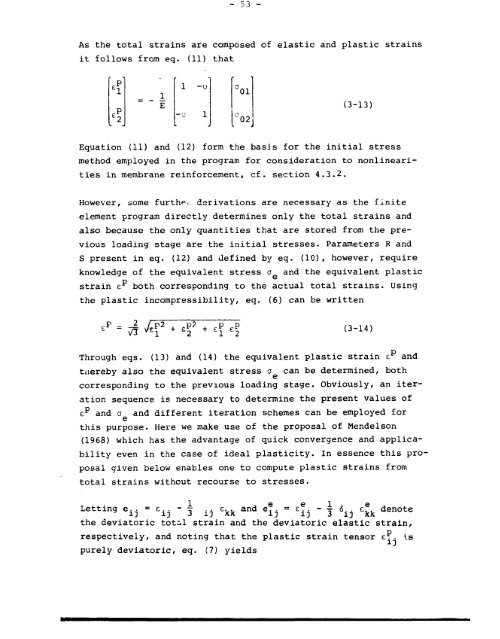Nonlinear Finite Element Analysis of Concrete Structures
Nonlinear Finite Element Analysis of Concrete Structures
Nonlinear Finite Element Analysis of Concrete Structures
You also want an ePaper? Increase the reach of your titles
YUMPU automatically turns print PDFs into web optimized ePapers that Google loves.
- 53 -<br />
As the total strains are composed <strong>of</strong> elastic and plastic strains<br />
it follows from eq. (11) that<br />
1<br />
E<br />
r<br />
1<br />
-u<br />
"I<br />
-u<br />
1<br />
r<br />
a oi<br />
a 02<br />
(3-13)<br />
r<br />
Equation (11) and (12) form the basis for the initial stress<br />
method employed in the program for consideration to nonlinearities<br />
in membrane reinforcement, cf. section 4.3.2.<br />
However, some furthe.- derivations are necessary as the finite<br />
element program directly determines only the total strains and<br />
also because the only quantities that are stored from the previous<br />
loading stage are the initial stresses. Parameters R and<br />
S present in eq. (12) and defined by eq. (10), however, require<br />
knowledge <strong>of</strong> the equivalent stress a and the equivalent plastic<br />
strain e both corresponding to the actual total strains. Using<br />
the plastic incompressibility, eq. (6) can be written<br />
£ P =<br />
VT V/E?2 + e5 ? + e? e? (3-14)<br />
Through eqs. (13) and (14) the equivalent plastic strain e p<br />
tuereby also the equivalent stress a<br />
can be determined, both<br />
corresponding to the previous loading stage. Obviously, an iteration<br />
sequence is necessary to determine the present values <strong>of</strong><br />
e p and a and different iteration schemes can be employed for<br />
e<br />
this purpose. Here we make use <strong>of</strong> the proposal <strong>of</strong> Mendelson<br />
(1968) which has the advantage <strong>of</strong> quick convergence and applicability<br />
even in the case <strong>of</strong> ideal plasticity. In essence this proposal<br />
given below enables one to compute plastic strains from<br />
total strains without recourse to stresses.<br />
Letting e ±j = c ±j - §<br />
and<br />
.., e kk and ej., = z e ±. - ± 6. . ej fc denote<br />
the deviatoric total strain and the deviatoric elastic strain,<br />
respectively, and noting that the plastic strain tensor e?. is<br />
purely deviatoric, eq. (7) yields
















